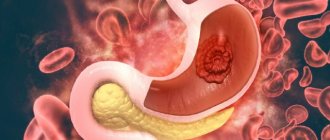Most patients, whom doctors have diagnosed with stage cancer and metastases, ask mainly about what are the chances of getting rid of the problem. It is the stages of cancer and metastases that determine life expectancy. For example, in stage 4 cancer, when metastases are widespread and considered incurable, patients tend to prepare only for the worst. In fact, the answer to the question is far from clear; the stage of cancer and metastases of the disease may not always mean death.
In some cases, primary formation can become a significant problem, in which it is difficult to predict a favorable prognosis. Conversely, cancer stage and metastases can be significantly mitigated by many factors, because There are many nuances that affect the prognosis of tumor spread:
- Ki67 index, - cell differentiation, - mutations, - tumor localization in the body, - features of detected metastases and other points.
What is stomach cancer?
This is a malignant tumor growing from the mucous membrane - the innermost layer of the stomach wall. It is this layer that comes into contact with food and gastric juice.
Like any other malignant tumor, it is characterized by gradual but inexorable growth and, upon reaching a certain phase of its development, can give metastases - secondary tumor nodes in other organs (liver, lungs, bones, lymph nodes, ovaries, and so on).
Stomach cancer is dangerous not only because, in the process of its growth, it depletes the human body (this is a feature of all malignant tumors), but also because it can lead to serious and life-threatening complications, even if it is in a treatable stage.
The most common complications are:
- bleeding from the tumor,
- perforation of the tumor (that is, its rupture with the formation of a through hole into the abdominal cavity)
- overlap (stenosis) of the outlet or inlet of the stomach with the development of serious nutritional disorders.
Among all types of tumors, stomach cancer is the most common. About 90-95% of all stomach tumors are malignant. Thus, any tumor-like lesion of the stomach wall, and even more so of its mucous membrane, is a very serious suspicion of stomach cancer, requiring a thorough, timely and comprehensive examination.
Statistics
Stomach cancer is one of the most common types of tumor lesions of human organs. This disease ranks 6th in the structure of the incidence of malignant diseases in the world. In the Republic of Belarus, stomach cancer ranks 4th in the structure of cancer diseases in men and 6th in women.
More than 780 thousand people in the world die every year from stomach cancer. Speaking about global mortality statistics due to malignant tumors, it should be noted that only lung and colon cancer are ahead of stomach cancer.
Causes
If we talk about cancer, in most cases the reasons for their development are not entirely clear, but there are factors that contribute to the occurrence of the disease. Stomach cancer is no exception.
So, the factors influencing its occurrence include:
- Genetic inheritance;
- Drinking alcohol and smoking;
- Helicobacter pylori bacteria, which cause gastritis and stomach ulcers;
- The influence of chemicals (toxins, nitrates, nitrites);
- Poor nutrition;
- Radiation exposure (eg, natural radiation, working in harsh conditions).
Additional factors that can cause stomach cancer include so-called precancerous diseases:
- Chronic gastritis;
- Gastric adenoma;
- Deficiency anemia;
- Stomach ulcer.
Identification of factors helps to identify a risk group. People included in it should be most attentive to themselves and undergo preventive examinations. This will allow us to detect the presence of the disease in its initial stages, when there are no symptoms yet.
Classification of stomach cancer
The disease has several classifications. According to international
According to the World Health Organization (WHO), stomach cancer is divided into two categories: advanced and early.
In the first half of the twentieth century, they began to use morphological
classification according to anatomical characteristics:
- the first type of stomach cancer (Type 1) - polypoid or mushroom-shaped - in the form of a mushroom, plaque, polyp - clearly separated from healthy tissue and has a stalk;
- the second type of stomach cancer (Type 2) is exophytic ulcerated or saucer-shaped; such stomach cancer has raised edges and clearly defined boundaries. This type of disease is the destructive stage of fungal and polypoid cancer;
- the third type of stomach cancer (Type 3) is ulcerative-infiltrative, such cancer does not have a clear demarcation from the stomach wall, like the first type;
- the fourth type of stomach cancer (Type 4) is diffuse-infiltrative, in which the walls of the organ thicken, causing the stomach to look like a thick-walled tube;
- The fifth type of stomach cancer (Type 5) is unclassified stomach tumors.
In the next
There are only two types of classifications:
- intestinal type stomach cancer,
- diffuse type gastric cancer.
The name of the first suggests that it resembles intestinal tumors. Cancerous tissues are sharply defined glandular structures made of columnar epithelium. This type of disease is characterized by stages. The disease develops under the influence of the environment, poor lifestyle and nutrition. Affects the development of stomach cancer and the presence of the bacterium H. Pylori.
The cause of the second type may be the presence of a defective gene in the body. A feature of this type of lesion is the multifocal nature of the tumor. The disease develops quickly and aggressively. Urgent surgical treatment of this type of stomach cancer is required.
There is also a third type - a mixed type, where signs of both listed above are present.
According to histological
According to the classification type adopted by WHO in 2010, stomach tumors are divided into the following types:
- Adenocarcinoma - papillary - tubular - mucinous - non-cohesive (signet ring cell) - mixed
- Glandular squamous cell carcinoma
- Medullary carcinoma
- Squamous cell carcinoma
- Hepatoid adenocarcinoma
- Undifferentiated cancer
- Neuroendocrine tumor G1 (carcinoid)
- Neuroendocrine tumor G2
- Neuroendocrine carcinoma
- Small cell neuroendocrine cancer
- Large cell neuroendocrine carcinoma
- Mixed glandular-neuroendocrine carcinoma
Adenocarcinoma comes first
– the most common and aggressive type of stomach cancer. Successful treatment of gastric adenocarcinoma is only possible with early diagnosis. Only in this case is a high survival rate (up to 90%) possible. The disease affects the glandular epithelium of the organ. When diagnosed with gastric adenocarcinoma, surgical treatment is essentially the only option for a complete cure, since gastric adenocarcinoma is a tumor insensitive to chemotherapy.
Treatment of other rare histological types of gastric cancer differs fundamentally little from the treatment of adenocarcinoma, since in all cases the issue of surgical treatment is considered at the first stage. The histological variant of the tumor plays a major role primarily in planning drug treatment, that is, chemotherapy, since different tumor variants differ in their sensitivity to chemotherapy.
Stages of stomach cancer
The extent of damage to an organ by cancer cells is most often determined after surgery. To assess the stage of the disease, several factors are taken into account:
- depth of damage to the gastric wall;
- whether the lymph nodes located directly near the stomach are affected by metastases;
- whether there are metastases in distant lymph nodes and/or other organs.
Stage 0
— pathology in cells is detected in the very superficial layer of the gastric mucosa.
Stage 1
- the tumor penetrates into single lymph nodes, as well as into the muscular layer of the stomach wall.
Stage 2
- cancer cells affect the outer layer of the gastric wall and a larger number of lymph nodes - At this stage, there are no distant metastases (that is, tumor foci in other organs and/or distant lymph nodes).
Stage 3
- spread of a malignant tumor to the outermost - serous layer of the stomach wall. Cancer cells invade nearby internal abdominal organs and also affect the lymph nodes.
Stage 4
– the latter – is diagnosed if the patient has metastases in distant lymph nodes and/or other organs.
Chemotherapy for liver metastases
Traditional cytostatic drugs for secondary tumor lesions of the liver rarely demonstrate effectiveness. However, in accordance with international treatment protocols, the use of multi-drug chemotherapy is sometimes recommended. Their choice mainly depends on the type of tumor that is the primary one.
In addition, targeted therapy is widely used today. It uses drugs that have a specific “target” of action - a specific molecule necessary for the growth and survival of cancer cells.
The most common targeted drug for metastatic primary liver cancer is sorafenib.
In addition, a number of other modern techniques can be used to treat liver metastases:
- radiosurgery;
- selective internal irradiation of the tumor focus (SIRT);
- proton and thermal effects;
- transcatheter embolization of tumor foci;
- implantation of port systems into liver vessels for infusion of chemotherapy drugs;
- external radiation exposure.
Symptoms
The first signs of an incipient disease are invisible. The patient may experience periodic pain and mild discomfort in the stomach, nausea, loss of appetite, vomiting, weakness, and heartburn.
At a later stage of oncology development, bleeding, belching, changes in stool and its color (with chronic leakage of blood from the stomach, the stool becomes black), weight loss, a feeling of fullness in the stomach, constant nausea, yellowness of the skin and eyes appear.
Diagnosis of stomach cancer
The effectiveness of treatment for stomach cancer depends on the timely detection of a developing tumor. Diagnosis of stomach cancer includes two types:
- primary;
- clarifying.
Primary examination
Primary diagnostic methods for stomach cancer include (primary diagnosis allows you to determine the presence of a tumor):
- Esophagogastroduodenoscopy (EGD) with targeted biopsy (taking pieces of tissue for subsequent histological examination). It allows you to confirm or refute the diagnosis, determine the type of cancer cells, and see changes in the mucosa.
Clarifying diagnostics
After confirming the presence of a tumor in the stomach, a clarifying diagnosis is prescribed, which makes it possible to determine the extent of the existing tumor. This may include examination methods such as:
- Computed tomography of the abdominal and thoracic cavities, pelvic cavity with intravenous contrast of vessels if necessary - the method allows you to assess the nature of the spread of the tumor, the involvement of adjacent organs, large vessels, etc.;
- Positron emission tomography of the whole body is a method that includes computed tomography and the simultaneous injection of a radioactive drug into the vascular bed, by the glow of which the nature of the spread of the tumor is more reliably determined (this method has a number of limitations in relation to stomach cancer, since this type of tumor belongs to tumors that do not readily accumulate radioactive drugs (fluorodeoxyglucose);
- Ultrasound examination of the abdominal organs and retroperitoneal space is used to detect the boundaries of the tumor, its growth into nearby lymph nodes and organs, the spread of metastases, the presence of ascitic (metastatic) fluid in the abdominal cavity, etc.;
- Endoultrasonography of the stomach combines two methods: endoscopy and ultrasound and allows you to assess the growth of a tumor into the depths of the gastric wall from inside the stomach cavity. The method is especially relevant in cases of early gastric cancer, since it is in such cases that it is possible to remove the formation immediately during endoscopy without extensive surgical interventions.
- X-ray of the digestive tract with barium. A contrast agent helps to see the boundaries of a tumor in the stomach, determine the degree of narrowing of the stomach by a tumor, the presence of intestinal obstruction in case of metastatic damage to the intestinal walls, etc.;
- Laparoscopy under anesthesia through punctures helps determine the stage of the disease and detect the location of metastases that are not visible with CT and ultrasound.
Functional diagnostics
It is carried out after a clarifying diagnosis and sets the task of determining whether it is possible to carry out the planned antitumor treatment in a particular patient. The range of examinations varies for each individual patient, but usually includes: blood tests, ECG, assessment of respiratory reserves, ECHO-CG (ultrasound examination of the heart), HM-ECG (24-hour ECG monitoring), ultrasound of the vessels of the neck and lower extremities and many others .
Important to remember
- Cancer patients often experience depression, anxiety, sleep disturbances, and irritability. In remission, they may experience post-traumatic stress disorder, substance abuse, and suicidal behavior.
- Most people react to a cancer diagnosis according to the Kübler-Ross model: they deny the disease, get angry, bargain, experience depression and eventually come to terms with their condition.
- Depression may reduce the likelihood of a positive outcome with treatment. At the same time, studies indicate that patients without depression have a higher chance of recovery
- Patients often become depressed and anxious due to misinformation about their illness and lack of psychological help. The task of a psychiatrist and medical psychologist is to balance the emotional background and correct the mental status with the help of medications, psychotherapy and psychological training.
Treatment methods for stomach cancer
Where to treat stomach cancer - abroad or in Belarus - is up to the patient to decide.
Belarusian centers employ highly qualified oncologists. If stomach cancer is diagnosed and treated in time in Belarus, high survival rates can be achieved.
The main methods of treating stomach cancer include surgery, drugs and radiation.
Surgical method
The most common radical treatment is surgical removal of stomach cancer. Minsk is a city where such operations are carried out on a regular basis. This method is used at different stages of cancer treatment.
In the initial stage of the disease, it is possible to use endoscopic treatment, that is, removal of the tumor through an endoscope during endoscopy, or removal of only a small section of the gastric wall with the tumor during surgery, while preserving the organ.
At later stages of the disease, the scope of intervention will be different: either part of the stomach is removed (resection) or the entire organ (gastrectomy). In addition to removing the organ itself with the tumor, the lymph nodes surrounding the stomach must also be removed.
At stage 4 of the disease, the possibilities of surgical treatment are reduced to reducing the patient’s suffering. Operations are performed to install feeding tubes (for feeding), eliminate obstructions, and only if there is an immediate threat to the patient’s life (bleeding or tumor disintegration, due to which the patient will die without treatment within hours or days), operations are performed to remove the stomach with the tumor.
Chemotherapy (drug therapy)
Such treatment in the Republic of Belarus is prescribed after gastric surgery to consolidate the results of surgical treatment and delay the possible return of the disease. This therapy is carried out in courses (usually two or three) and sometimes in combination with radiation therapy.
Several medications may be used simultaneously during treatment. They are administered intravenously. Different drugs have different effects on cancer cells, preventing them from dividing and destroying them. The cost of chemotherapy for stomach cancer largely depends on the number of drugs prescribed.
For advanced gastric cancer, perfusion thermochemotherapy, which is carried out immediately after surgery after tumor removal in an operating room, deserves special attention. A heated solution of chemotherapy drugs is injected into the abdominal cavity for several hours. This treatment can significantly reduce the likelihood of the disease returning in the abdominal cavity.
Radiation therapy
The essence of the method is that the patient is exposed to ionizing radiation. This allows you to slow down the growth of the tumor and kill its cells. Radiation therapy for stomach cancer in the Republic of Belarus is carried out according to indications after surgery in combination with chemotherapy.
Specialists use two types of radiation therapy:
- remote;
- brachytherapy.
In the first case, using special equipment, the beam affects the tumor, passing through healthy organs and tissues. In the second, a catheter, needle, string or grain filled with radioactive substances is inserted into the malignant neoplasm.
How to treat liver metastases?
The choice of the optimal treatment regimen for this pathology depends on:
- size of the secondary lesion;
- the exact location of its location;
- patient's age;
- its general condition and other parameters.
But the most radical and effective way to get rid of liver metastases is surgical intervention. The operation in this case involves removal of the lobe of the liver in which the secondary lesion was identified. In some cases, when the tumor is large enough, resection of half the liver may be required. Sometimes the decision on the amount of tissue to be removed is made by the surgeon directly during the intervention - based on the results of a biopsy, which is performed directly in the operating room.
The technique of performing interventions can be either traditional, with wide access through the abdominal wall, or laparoscopic. The latter method is preferable due to less tissue trauma, but it can only be used for single small metastases.
Disease prognosis
The success of treatment depends largely on early diagnosis of the disease and the selection of appropriate treatment methods.
The general state of a person’s health is also important, because there are factors that lead to the development of the disease: alcohol abuse, unhealthy lifestyle, heredity.
The success of treatment also depends on the identified stage of oncology. In the initial phase, the survival rate reaches 70-80%, in the second – 50-60%. In the third and fourth stages, the survival rate is even lower. Therefore, it is so important to consult a doctor in a timely manner if you have any health complaints.
Prevention
Preventive measures for this disease can be grouped into two areas - primary (the active participation of a person is necessary) and secondary (the qualifications of a doctor are important).
The primary ones include:
- Rejection of bad habits;
- Proper balanced nutrition;
- Preventive examinations for the purpose of early diagnosis of the disease.
The secondary focus includes working with people at risk. Here it is important to control precancerous diseases - chronic gastritis, stomach ulcers, polyposis.
The success of medical efforts largely depends on how we treat our health. The doctors of the Onco.Rehab integrative oncology clinic wish you health and invite you to treatment.
Price list
*Note:
Prices are indicated for foreign citizens. Citizens of the Republic of Belarus can receive medical services without charging a fee. Read more...
*Prices are indicative, because Payment for services is made in Bel. rub. *You can view all types of services and exact prices on the page
| Type of medical research | Price, RUB | Price, USD |
| Esophagogastroduodenoscopy | 5744 | 90 |
| Hematological studies | ||
| Determination of erythrocyte sedimentation rate | 191 | 3 |
| For non-hematological diseases (single) | 766 | 12 |
| Myelogram counting | 5234 | 82 |
| Research using automatic hematology analyzers, with differentiation of leukocyte formula | 957 | 15 |
| Biochemical research | ||
| Determination of potassium, sodium and chlorine using automatic analyzers (single) | 765 | 12 |
| Determination of acid-base status of blood using automatic analyzers (single) | 574 | 9 |
| Study of biopsy and surgical material (for 1 study number) | 1787 | 28 |







